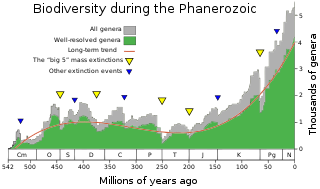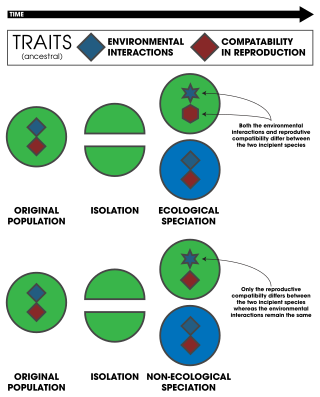
In evolutionary biology, adaptive radiation is a process in which organisms diversify rapidly from an ancestral species into a multitude of new forms, particularly when a change in the environment makes new resources available, alters biotic interactions or opens new environmental niches. Starting with a single ancestor, this process results in the speciation and phenotypic adaptation of an array of species exhibiting different morphological and physiological traits. The prototypical example of adaptive radiation is finch speciation on the Galapagos, but examples are known from around the world.

The Cenozoic is Earth's current geological era, representing the last 66 million years of Earth's history. It is characterised by the dominance of mammals, birds, and angiosperms. It is the latest of three geological eras, preceded by the Mesozoic and Paleozoic. The Cenozoic started with the Cretaceous–Paleogene extinction event, when many species, including the non-avian dinosaurs, became extinct in an event attributed by most experts to the impact of a large asteroid or other celestial body, the Chicxulub impactor.
Macroevolution usually means the evolution of large-scale structures and traits that go significantly beyond the intraspecific variation found in microevolution. In other words, macroevolution is the evolution of taxa above the species level.

The Ordovician is a geologic period and system, the second of six periods of the Paleozoic Era. The Ordovician spans 41.6 million years from the end of the Cambrian Period 485.4 Ma to the start of the Silurian Period 443.8 Ma.
Speciation is the evolutionary process by which populations evolve to become distinct species. The biologist Orator F. Cook coined the term in 1906 for cladogenesis, the splitting of lineages, as opposed to anagenesis, phyletic evolution within lineages. Charles Darwin was the first to describe the role of natural selection in speciation in his 1859 book On the Origin of Species. He also identified sexual selection as a likely mechanism, but found it problematic.

Trilobites are extinct marine arthropods that form the class Trilobita. Trilobites form one of the earliest known groups of arthropods. The first appearance of trilobites in the fossil record defines the base of the Atdabanian stage of the Early Cambrian period and they flourished throughout the lower Paleozoic before slipping into a long decline, when, during the Devonian, all trilobite orders except the Proetida died out. The last trilobites disappeared in the mass extinction at the end of the Permian about 251.9 million years ago. Trilobites were among the most successful of all early animals, existing in oceans for almost 270 million years, with over 22,000 species having been described.

Afrotheria is a superorder of mammals, the living members of which belong to groups that are either currently living in Africa or of African origin: golden moles, elephant shrews, otter shrews, tenrecs, aardvarks, hyraxes, elephants, sea cows, and several extinct clades. Most groups of afrotheres share little or no superficial resemblance, and their similarities have only become known in recent times because of genetics and molecular studies. Many afrothere groups are found mostly or exclusively in Africa, reflecting the fact that Africa was an island continent from the Cretaceous until the early Miocene around 20 million years ago, when Afro-Arabia collided with Eurasia.

This is a list of topics in evolutionary biology.

The Cambrian–Ordovician extinction event, also known as the Cambrian-Ordovician boundary event, was an extinction event that occurred approximately 485 million years ago (mya) in the Paleozoic era of the early Phanerozoic eon. It was preceded by the less-documented End-Botomian mass extinction around 517 million years ago, and the Dresbachian extinction event about 502 million years ago.
The Great Ordovician Biodiversification Event (GOBE), was an evolutionary radiation of animal life throughout the Ordovician period, 40 million years after the Cambrian explosion, whereby the distinctive Cambrian fauna fizzled out to be replaced with a Paleozoic fauna rich in suspension feeder and pelagic animals.
The Cambrian explosion is an interval of time approximately 538.8 million years ago in the Cambrian period of the early Paleozoic when there was a sudden radiation of complex life, and practically all major animal phyla started appearing in the fossil record. It lasted for about 13 to 25 million years and resulted in the divergence of most modern metazoan phyla. The event was accompanied by major diversification in other groups of organisms as well.
The cat gap is a period in the fossil record of approximately 25 million to 18.5 million years ago in which there are few fossils of cats or cat-like species found in North America. The cause of the "cat gap" is disputed, but it may have been caused by changes in the climate, changes in the habitat and environmental ecosystem, the increasingly hypercarnivorous trend of the cats, volcanic activity, evolutionary changes in dental morphology of the Canidae species present in North America, or a periodicity of extinctions called van der Hammen cycles.

The Avalon explosion, named from the Precambrian faunal trace fossils discovered on the Avalon Peninsula in Newfoundland, eastern Canada, is a proposed evolutionary radiation of prehistoric animals about 575 million years ago in the Ediacaran period, with the Avalon explosion being one of three eras grouped in this time period. This evolutionary event is believed to have occurred some 33 million years earlier than the Cambrian explosion, which had been long thought to be when complex life started on Earth.
In evolutionary biology, a key innovation, also known as an adaptive breakthrough or key adaptation, is a novel phenotypic trait that allows subsequent radiation and success of a taxonomic group. Typically they bring new abilities that allows the taxa to rapidly diversify and invade niches that were not previously available. The phenomenon helps to explain how some taxa are much more diverse and have many more species than their sister taxa. The term was first used in 1949 by Alden H. Miller who defined it as "key adjustments in the morphological and physiological mechanism which are essential to the origin of new major groups", although a broader, contemporary definition holds that "a key innovation is an evolutionary change in individual traits that is causally linked to an increased diversification rate in the resulting clade".
The concept of the three great evolutionary faunas of marine animals from the Cambrian to the present was introduced by Jack Sepkoski in 1981 using factor analysis of the fossil record. An evolutionary fauna typically displays an increase in biodiversity following a logistic curve followed by extinctions.

The Mesozoic–Cenozoic Radiation is the third major extended increase of biodiversity in the Phanerozoic, after the Cambrian Explosion and the Great Ordovician Biodiversification Event, which appeared to exceeded the equilibrium reached after the Ordovician radiation. Made known by its identification in marine invertebrates, this evolutionary radiation began in the Mesozoic, after the Permian extinctions, and continues to this date. This spectacular radiation affected both terrestrial and marine flora and fauna, during which the "modern" fauna came to replace much of the Paleozoic fauna. Notably, this radiation event was marked by the rise of angiosperms during the mid-Cretaceous, and the K-Pg extinction, which initiated the rapid increase in mammalian biodiversity.

Ecological speciation is a form of speciation arising from reproductive isolation that occurs due to an ecological factor that reduces or eliminates gene flow between two populations of a species. Ecological factors can include changes in the environmental conditions in which a species experiences, such as behavioral changes involving predation, predator avoidance, pollinator attraction, and foraging; as well as changes in mate choice due to sexual selection or communication systems. Ecologically-driven reproductive isolation under divergent natural selection leads to the formation of new species. This has been documented in many cases in nature and has been a major focus of research on speciation for the past few decades.

The following outline is provided as an overview of and topical guide to evolution:
Nonadaptive radiations are a subset of evolutionary radiations that are characterized by diversification that is not driven by resource partitioning. The species that are a part of a nonadaptive radiation will tend to have very similar niches, and in many cases will be morphologically similar. Nonadaptive radiations are driven by nonecological speciation. In many cases, this nonecological speciation is allopatric, and the organisms are dispersal-limited such that populations can be geographically isolated within a landscape with relatively similar ecological conditions. For example, Albinaria land snails on islands in the Mediterranean and Batrachoseps salamanders from California each include relatively dispersal-limited, and closely related, ecologically similar species often have minimal range overlap, a pattern consistent with allopatric, nonecological speciation. In other cases, such as certain damselflies and crickets from Hawaii, there can be range overlap in closely related species, and it is likely that sexual selection plays a role in maintaining species boundaries.

When speciation is not driven by divergent natural selection, it can be said to be nonecological, so as to distinguish it from the typical definition of ecological speciation: "It is useful to consider ecological speciation as its own form of species formation because it focuses on an explicit mechanism of speciation: namely divergent natural selection. There are numerous ways other than via divergent natural selection in which populations might become genetically differentiated and reproductively isolated." It is likely that many instances of nonecological speciation are allopatric, especially when the organisms in question are poor dispersers, however sympatric nonecological speciation may also be possible, especially when accompanied by an "instant" loss of reproductive compatibility, as when polyploidization happens. Other potential mechanisms for nonecological speciation include mutation-order speciation and changes in chirality in gastropods.












